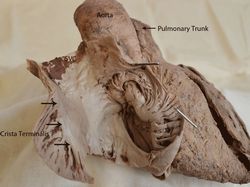The anatomical term [crista terminalis] is Latin. [Crista] refers to the crest of a helmet, a tuft (of hair or feathers), or a ridge. The word [terminalis] means "end" or "terminal". The term then means "the terminal or end ridge".
The crista terminalis is a superoinferior muscular ridge found in the right atrium marking the boundary between the smooth wall of the right atrium, also known as the "sinus venarum" (venous sinus), and the muscular wall of the right atrial appendage. The muscular wall of the right atrial appendage is comb-shaped and is called the pectinate muscle.
Because of the longitudinal direction of the muscular fibers of the crista terminalis, it is considered to be one of the pathways for electrical transmission of the cardiac depolarization between the sinuatrial (SA) node and the atrioventricular (AV) node.
The crista terminalis causes a superoinferior longitudinal depression on the surface of the heart known as the sulcus terminalis.
The accompanying image is a dissection of a human heart and shows the crista terminalis, pectinate muscle, fossa ovalis, the ostium of the coronary sinus, the right atrial smooth wall of the sinus venarum. Click on the image for a larger version. The animated image does a slow pass trough all these and other structures.
Sources:
1. "The origin of Medical Terms" Skinner, AH, 1970
2. "Terminologia Anatomica: International Anatomical Terminology (FCAT)" Thieme, 1998
3. "Tratado de Anatomia Humana" Testut et Latarjet 8th Ed. 1931 Salvat Editores, Spain
Image courtesy of Rocky Vista University,College of Osteopathic Medicine, Parker, CO




